RBA Annual Conference – 2002 Discussion
1. Moisés J Schwartz[1]
Globalisation, living standards and equity: the case of Mexico
Introduction
One of the distinguishing patterns of the ongoing wave of globalisation is the depth of economic integration. Measured in terms of trade and capital flows, the current wave of globalisation is certainly without precedent. As presented in a recent study by the World Bank (2002b), this third wave of globalisation (with the first one occurring between 1870 and 1914 and the second one between 1945 and 1980) offers unique opportunities to many developing countries – the ‘new globalisers’ as they are called in the study – to improve national welfare.
Mexico appears not only as one of the most aggressive ‘new globalisers’, but also as one of the most relevant test cases when assessing the social benefits of globalisation, given its longstanding history of poverty and income inequality. Like many other countries in Latin America, these unfavourable social conditions can be traced back to Mexico's birth as an independent nation nearly two centuries ago. Improving social conditions of the population has thus been one of the most pressing challenges for policy-makers.
Poverty and inequality in Mexico can be attributed to three key elements: unequal factor endowments (land, natural resources), lack of human capital formation (education and health care) and poor institutions (flawed institutional design, poorly defined property rights and lack of contract enforcement).[2] This paper argues that globalisation has provided a window of opportunity to overcome these factors and break the cycle that perpetuated poverty and inequality from generation to generation in vast segments of the population. It shows that, despite the setbacks of the 1994–95 crisis, some of the benefits of a more globalised economy have already happened nationwide as indicated by broad social indicators, including education and health. Moreover, the paper points out that those regions of Mexico that have been more exposed to global economic integration, as reflected by growing trade and capital flows, have also shown the most significant social improvements.
To expand the benefits of globalisation more broadly, particularly in a country deeply divided along regional and social cleavages like Mexico, strengthening domestic institutions and policies is crucial. Mexico's experience with a pro-growth and pro-‘public spending on the poor’ policy, while promoting macroeconomic stability, has been of paramount importance for better equipping the poor and most vulnerable social groups in order to benefit from globalisation.
Mexico's experience with globalisation shows that progress in equity and living standards cannot be achieved without an appropriate economic policy mix aimed at securing stability and economic growth. In recent years, economic growth has resumed while inflation and the public deficit have been drastically reduced. Moreover, interest rates have shown a declining trend while domestic savings and foreign direct investment have increased, thus allowing Mexico to be considered a stable and sound economy. This has been possible thanks to the implementation of coherent fiscal and monetary policies and by Mexico's clear commitment to deepen structural reform. With poverty and inequality still prevalent in Mexico, the maintenance of stability and reform is crucial so that globalisation can truly work for all.
The paper is structured in three sections. The first section presents a brief overview of Mexico's insertion to globalisation, highlighting the fact that the impact has been clearly differentiated along regional lines. For this purpose, the data used throughout the paper are presented on a regional basis. The second section analyses the social impact of globalisation in terms of both poverty and income distribution, based on official information provided by the National Household and Income Surveys from the National Institute of Statistics, Geography and Informatics (INEGI), as well as in regard to broader internationally used indices and other specific indicators such as health and education. The third section discusses some public policy responses and ongoing challenges, particularly by looking at the recent trends in public spending. Finally, we present some concluding remarks.
Mexico's insertion into the third wave of globalisation: a tale of regional disparities
Over the past two decades, Mexico underwent a radical transformation, shifting from being a closed and tightly government-controlled economy to being one of the most open and market-oriented economies in the world. The turning point of this transformation can be traced back to the debt crisis of the early 1980s, which forced the implementation of drastic stabilisation and adjustment policies, leading eventually to the opening of the economy in an unprecedented manner. In 1986, Mexico joined the GATT in a three-fold effort to stimulate non-oil exports, enhance economic efficiency and impose price discipline on domestic firms.
The success of this policy became more evident in the late 1980s, when the non-oil export sector became the driving force of economic growth. Automobile and computer plants, together with maquiladoras (in-bond industry), settled under special fiscal programs along the northern border, thus becoming the most dynamic sectors of the economy, turning around the composition of exports in Mexico. Oil-related products' share of total exports decreased from 90 per cent in 1982 to 25 per cent in 1990, dropping later on to less than 10 per cent a decade later.
The consolidation of an export-oriented economy was achieved in the early 1990s through the implementation of a number of free trade arrangements. In 1994, the North American Free Trade Agreement with the US and Canada (NAFTA) was implemented and Mexico further institutionalised its commitment to integrate into the world economy. This was subsequently enhanced through the implementation of similar trade arrangements with a wide array of countries, including Chile, Bolivia, Colombia, Venezuela, Costa Rica, Nicaragua, Guatemala, Honduras, El Salvador, Israel, the European Union and the European Free Trade Association.
As a result of this policy, total foreign trade increased three-fold (from US$117 billion in 1993 to more than US$340 billion in 2000), while foreign trade doubled its share in the economy during the decade (from around 30 per cent of GDP in 1991 to 60 per cent in 2000). In the seven years since NAFTA was implemented, Mexican industry has been able to boost its US market shares in leading US import sectors, such as motor vehicles and auto parts (from 9 per cent to 16 per cent), electrical equipment (from 3 per cent to 17 per cent) and communications equipment (from 8 per cent to 22 per cent).
In addition to an ambitious trade liberalisation policy, the capital account was rapidly liberated in the early 1990s. Prior to that, foreign direct investment (FDI) faced very restrictive regulation. Attracting FDI was crucial not only for covering external financing needs, but also for stimulating competition and developing a more efficient economy. Following several legal reforms undertaken during the 1980s, a new law was enacted in 1993, repealing prior regulations and gradually allowing for up to 100 per cent foreign ownership in areas comprising nowadays more than 90 per cent of the economic activities accounted for in the national accounts. Free trade agreements such as NAFTA have been a driving force behind FDI increasing inflows, with multinational firms moving production lines to Mexico in order to enhance the efficiency of their regional and global networks.
Accordingly, annual FDI flows steadily expanded: from US$1.5 billion in 1984, to US$4.3 billion in 1993, and more recently up to US$23 billion in 2001 with the boost of a major acquisition by Citigroup in the banking sector. Between 1994 and 2001, FDI was concentrated primarily in manufacturing (51 per cent of total inflows) and services (33 per cent), with the remainder in mining and infrastructure.
The benefits of rapid global economic integration, however, have been unevenly distributed across the country, concentrating primarily in those regions with better infrastructure and closer to the US border. These regions host most of the maquiladora industry, traditional and high-tech, established in Mexico throughout the 1990s, which in turn accounts for a large share of Mexico's exports (48 per cent of total exports and 53 per cent of manufacturing exports in 2001).
The extent to which regions have been able to benefit from integration with the international economy has also been limited by Mexico's historical pattern of industrialisation and urbanisation, concentrated in a handful of cities. As mentioned in some recent studies, this pattern was reinforced by concentrated public investment and physical infrastructure in these regions (Tamayo-Flores 2001). Given the strong relationship between FDI and growth of exports seen in Mexico since the opening of the economy, it is worth considering how FDI flows have been distributed across the country and how this has affected regional economic growth.
Based on the regions established by the National Development Plan 2001–2006[3], 67 per cent of a total US$96.2 billion recorded in FDI between 1993 and 2001 went to the Centre, followed by the Northeast (19 per cent), the Northwest (8 per cent) and the Centre-West (5 per cent). The South-Southeast attracted practically no FDI during the period, with barely 1 per cent of total FDI flows (Figure 1).
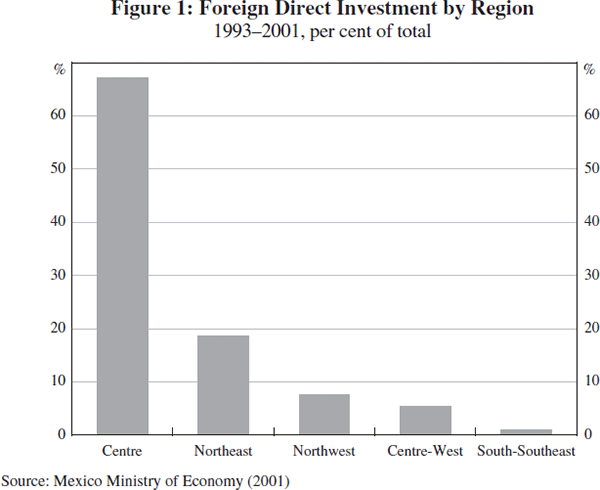
Given the concentration of FDI in manufacturing and services, those regions which benefited most from the opening of the economy were clearly the more urbanised and industrialised ones. By contrast, the agriculture-based economies of the South-Southeast were unable to either expand their exports or attract FDI. Indeed, agricultural export opportunities have been limited to a handful of modern producers, most of which enjoy the benefits of good infrastructure built around industrialised regions.
Regional economic growth reflects these disparities. Nationwide, Mexico's GDP grew at an annual average rate of almost 4 per cent between 1993 and 2000, despite the 6 per cent decline in economic activity seen in 1995 due to the crisis stemming from the abrupt peso devaluation.
Available data for the period 1993–2000 show that inter-regional disparities in terms of GDP growth have actually widened. In contrast with the Northeast region, which grew at an annual average rate of almost 5 per cent, the South-Southeast recorded only a 2.5 per cent annual average rate of growth. This differentiation is also reflected in terms of national GDP shares: whereas the Northeast increased its share of total national GDP from 17 per cent in 1993 to 19 per cent in 2000, the South-Southeast region's share declined from 15 per cent to 14 per cent during the same period. The Centre maintained an overwhelming share of total GDP at around 40 per cent (Figures 2 and 3).
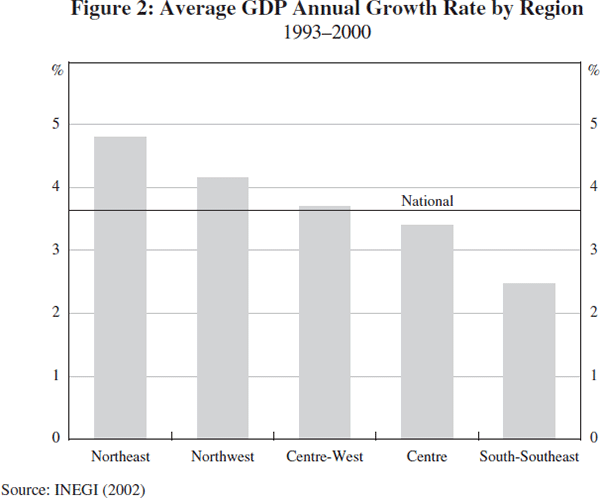
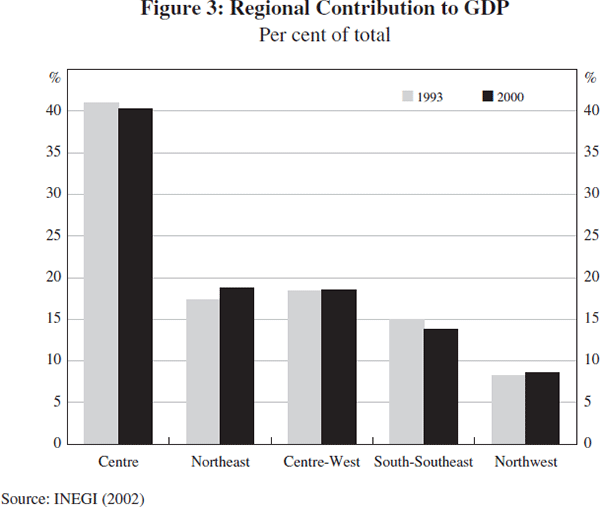
Similarly, product per capita shows significant differences across regions: in 2000 the South-Southeast region had the lowest regional product per capita (8,858.04 pesos), whereas the Northeast recorded the highest of the country (20,339.45 pesos). Moreover, the Northeast experienced the greatest variation in product per capita throughout the last decade, growing at an annual rate of 2 per cent between 1993 and 2000, moving from 17,887.39 pesos to 20,339.45 pesos, respectively (Figure 4).
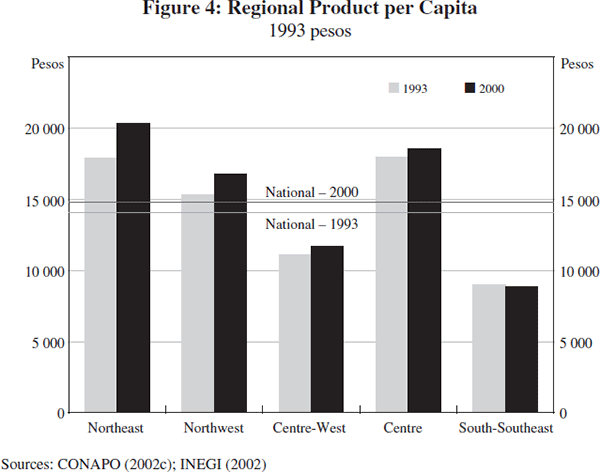
Income disparities among the 32 entities in which Mexico is administratively divided have persisted, and even increased. For example, consider the Southern state of Chiapas and the Federal District (the city capital), the entities with the lowest and highest income per capita in the country, respectively. Between 1993 and 2000, relative income per capita between these two areas grew from 5.7 to 6.1 in favour of the Federal District.
In sum, the economic reforms that accelerated Mexico's insertion into globalisation in the last decade have had a highly differentiated impact along regional lines. On the one hand, those states which have been able to attract FDI and increase exports have benefited the most in terms of economic growth. However, the South-Southeast has not experienced these developments, concentrating economic activity along a handful of traditional tourist and oil-related activities, with few or non-existent economic links with the rest of the region. The way this has affected population living standards is considered in the next section.
Evolution of social indicators
Income distribution and poverty
Assessing the evolution of income distribution and poverty in Mexico over the past two decades is not an easy task given the lack of consistent methodologies, as well as the difficulties with assessing the impact of the 1994–95 crisis. According to the data provided by INEGI, based on bi-annual income and expenditure surveys among Mexican households, income inequality during the 1990s remained relatively unchanged, following a surge in the late 1980s. With the exception of a fall in 1996 – as a result primarily of the drop in the share of income held by the top quintile in the aftermath of the 1994–95 crisis – the Gini coefficient rose slightly, reaching about 0.48 in 2000 (Figure 5).
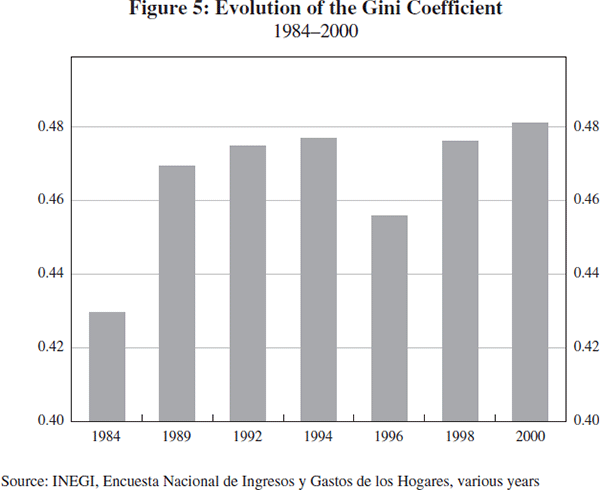
As seen in the Lorenz curve, this increase in income inequality reflects the growing income gap between the very rich and the rest of the population (see Figure 6 and Table 1).[4] In 2000, the richest 10 per cent of the population held 38.7 per cent of national income, considerably higher than the 32.8 per cent in 1984. By contrast, the poorest 10 per cent of the population held practically the same percentage of income as it did in the mid 1980s. The fifth to ninth deciles are the portion of the population that showed the most significant decline in income held. This means that rising inequality in the past 15 years has hit the middle and upper-middle classes the worst. According to some experts, this is a similar pattern to what has been observed in the rest of Latin America, and among other so-called ‘new globalisers’.[5]
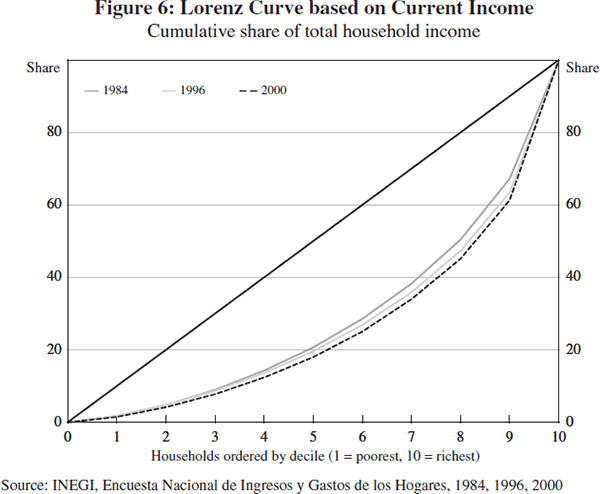
| Decile | 1984 | 1989 | 1992 | 1994 | 1996 | 1998 | 2000 |
|---|---|---|---|---|---|---|---|
| 1 (poorest) | 1.7 | 1.6 | 1.6 | 1.6 | 1.8 | 1.5 | 1.5 |
| 2 | 3.1 | 2.8 | 2.7 | 2.8 | 3.0 | 2.7 | 2.6 |
| 3 | 4.2 | 3.7 | 3.7 | 3.7 | 3.9 | 3.6 | 3.6 |
| 4 | 5.3 | 4.7 | 4.7 | 4.6 | 4.9 | 4.7 | 4.6 |
| 5 | 6.4 | 5.9 | 5.7 | 5.7 | 6.0 | 5.8 | 5.7 |
| 6 | 7.8 | 7.3 | 7.1 | 7.1 | 7.3 | 7.2 | 7.1 |
| 7 | 9.7 | 9.0 | 8.9 | 8.7 | 9.0 | 8.9 | 8.8 |
| 8 | 12.2 | 11.4 | 11.4 | 11.3 | 11.5 | 11.5 | 11.2 |
| 9 | 16.7 | 15.6 | 16.0 | 16.1 | 16.0 | 16.0 | 16.1 |
| 10 (richest) | 32.8 | 37.9 | 38.2 | 38.4 | 36.6 | 38.1 | 38.7 |
|
(a) Refers to total current income; includes monetary and non-monetary income Source: Author's estimates based on data from INEGI, Encuesta Nacional de Ingresos y Gastos de los Hogares, various years |
|||||||
Domestically, income inequality has varied across regions. According to urban-based data collected by Andalón-López and López-Calva (2002), during the 1990s the Gini coefficient increased considerably in two regions: in the South-Southeast it moved from around 0.44 in 1990 to just over 0.46 in 2000, while in the Centre it increased from about 0.46 to 0.50. In contrast, the Northwest was the only region in which the Gini coefficient showed a slight improvement, moving from about 0.45 in 1990 to 0.43 in 2000. The Northeast remained practically unchanged (Figure 7).
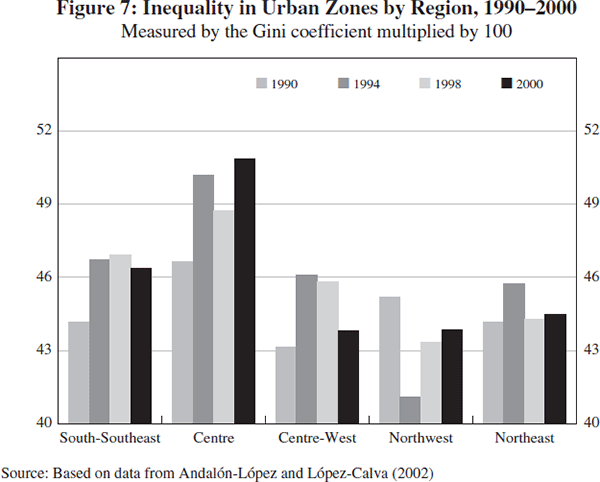
Broader differences arise when assessing poverty evolution. Based on the definition used by INEGI,[6] poverty and extreme poverty showed a downward trend which was reversed in the aftermath of the 1994–95 crisis, and then was later resumed in the late 1990s. By 2000, national levels of moderate poverty and extreme poverty were practically the same as in 1990, at 53 per cent and 23 per cent, respectively, of total population (Figure 8). However, due to demographic growth there was an increase in the absolute number of Mexicans living in poverty (from 45.4 million in 1992 to 52.4 million in 2000) and extreme poverty (from 19.7 million in 1992 to 23.3 million in 2000).
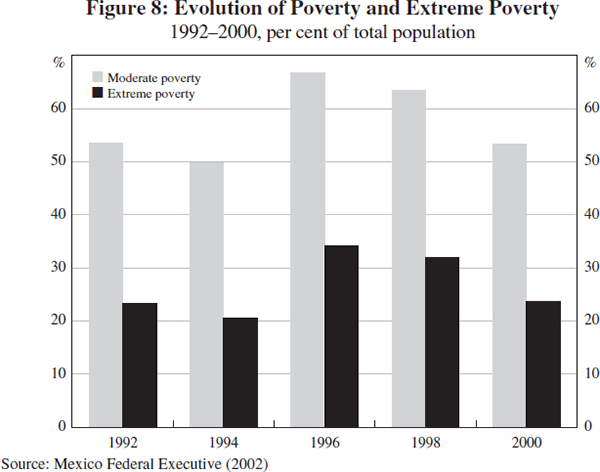
On a regional basis (Figure 9), the South-Southeast emerges with the worst picture, with 70 per cent of households below the poverty line throughout the 1990s. Although poverty levels remained unchanged in this region, the population in extreme poverty actually increased from 38 per cent in 1992 to 44 per cent in 2000 (Figure 10).
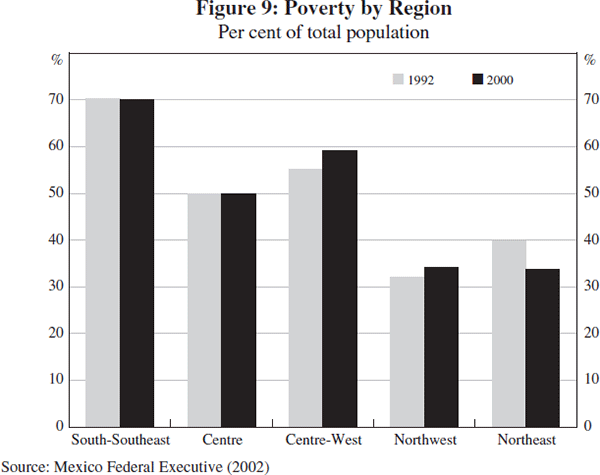
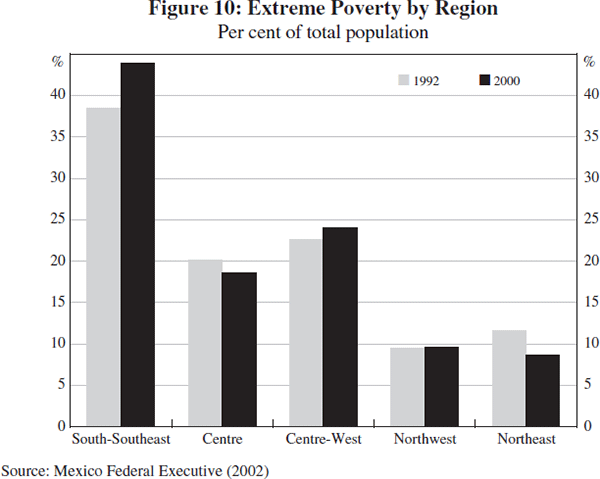
In the Centre, poverty also remained unchanged, with 50 per cent of the population under the poverty line, while extreme poverty slightly decreased. In the Centre-West and Northwest, poverty and extreme poverty increased slightly. By contrast, the Northeast – one of the most ‘globalised’ regions in the country – showed a significant overall improvement, with poverty dropping from 40 per cent in 1992 to 34 per cent in 2000 and extreme poverty falling from 12 per cent to 9 per cent, respectively.
In addition to regional differences, poverty assessments are further complicated by the strong bias against rural areas (Figure 11). Available information from INEGI indicates that the gap between rural and urban areas is significant, with the latter showing the most significant improvement in the late 1990s, following the sharp increase in the aftermath of the 1994–95 crisis. Overall, this is a significant improvement considering that 75 per cent of the population is concentrated in urban areas, and therefore better positioned to benefit from increasing global economic integration. By contrast, the fact that the remaining one-quarter of the population is widely dispersed in 184,000 rural villages, with less than 2500 inhabitants each, poses a significant challenge for extending the benefits of globalisation and thus reducing poverty (Mexico Federal Executive 2002).
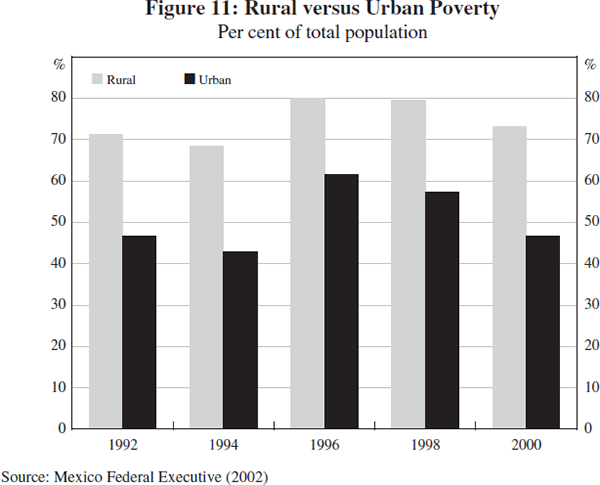
Social indices and Mexico's standing
An alternative way to see whether there have been any social improvements in Mexico under increasing globalisation is by looking at some aggregated indices which include other variables such as per capita income, life expectancy, education and health. The three main international indices considered in this regard are the Human Development Index (HDI), the Basic Welfare Index (BWI) and the Physical Quality of Life Index (PQLI).[7] The HDI was first introduced by the United Nations in 1990, whereas the BWI and PQLI have been used by some scholars (van der Lijn 1995) for purposes of comparing international well-being indicators. With the exception of the BWI, Mexico's recent evolution shows a steady improvement (Table 2).
| 1975 | 1980 | 1985 | 1990 | 2000 | |
|---|---|---|---|---|---|
| HDI(a) | 68.78 | 72.05 | 75.01 | 76.83 | 78.60 |
| BWI | 55.64 | 57.61 | 60.07 | 60.52 | 56.16 |
| PQLI | 47.80 | 48.99 | 51.67 | 52.69 | 56.14 |
|
(a) The HDI is multiplied by 100 for comparison purposes. In all cases, the higher the indices are, the more socially developed the country is. Source: Author's estimates based on World Bank (2002a), INEGI (2002) and UNDP (2001) |
|||||
A recent study (CONAPO 2002a) applies the HDI methodology domestically to analyse variations among states with data for 2000 (Figure 12). The results confirm that those regions more open to trade and capital flows have the highest ranking, while those lacking links with global economic integration are left far behind. The differences across states are remarkable: the Federal District had an HDI of 0.93 in 2000 – considered as ‘high human development’ in terms of the United Nations methodology – whereas the Southern state of Chiapas had an HDI of 0.51, ranking it closer to what would be internationally classified as ‘low human development’.
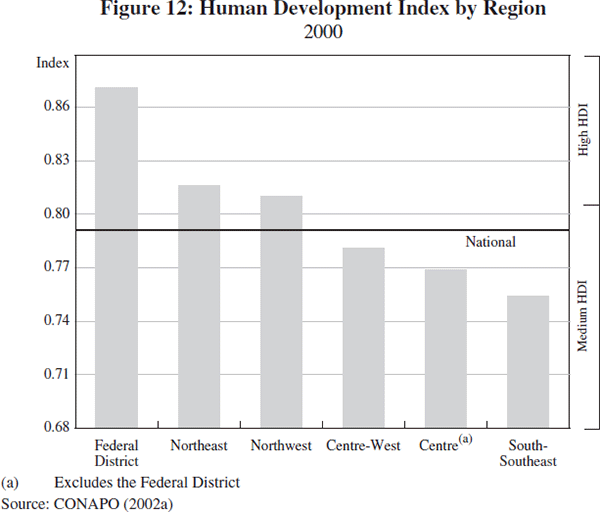
A similar picture arises when looking at the Marginalisation Index (MI) developed domestically by the National Population Council (CONAPO). This index shows the intensity of social marginalisation by looking at the population's access to basic goods and services.[8] According to this Index, the South-Southeast is the region with the highest marginalisation rate, exceeding by far the rest of the country. In contrast, the Northeast and Northwest show the lowest marginalisation, while the Centre and Centre-West are located between the two extremes. It should be noted that three Mexican regions showed a reduction in marginalisation during the 1990s, namely the Northeast, Centre and Centre-West (Figure 13).
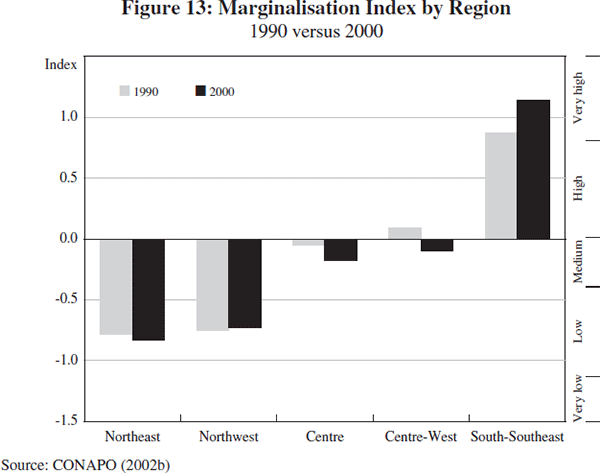
Differences in the MI are even stronger when looking at specific states rather than regions. The Federal District, as well as other outward-oriented states (such as Nuevo León, Baja California, Coahuila and Aguascalientes), have the lowest national ranking in marginalisation. On the opposite side, the southern states of Chiapas, Guerrero, Oaxaca, and Veracruz present the highest marginalisation scores. The Federal District is the least marginalised entity at the national level with −1.53, while the most marginalised state is Chiapas with 2.25.
Education and health as driving forces of social improvement in Mexico
Over the past decade, Mexico achieved significant improvements in education and health, although several challenges remain. Three particular achievements in education are worth mentioning based on the results of the 2000 Census: reduction of illiterate population, expansion of enrolment rates and increase in average years of education.
Illiteracy rates were improved from 13 per cent in 1990 to 10 per cent in 2000, although significant regional differences persisted. For instance, in the Centre and northern regions illiteracy rates were around 5 per cent in 2000, whereas in the Southern state of Chiapas they were close to 27 per cent, despite the reduction in 6 percentage points observed by the latter during the decade.
Basic education enrolment rates for the population between 6 and 14 years old increased from 86 per cent in 1990 to 92 per cent in 2000 (Figure 14). Moreover, these improvements in basic education were accompanied by reductions in gender differences, with girls recording a higher enrolment rate than boys in some grades.[9] Finally, average years of schooling for the population as a whole increased to 7.6 years, in contrast to 6.6 years in 1990 and 3 years in 1970.
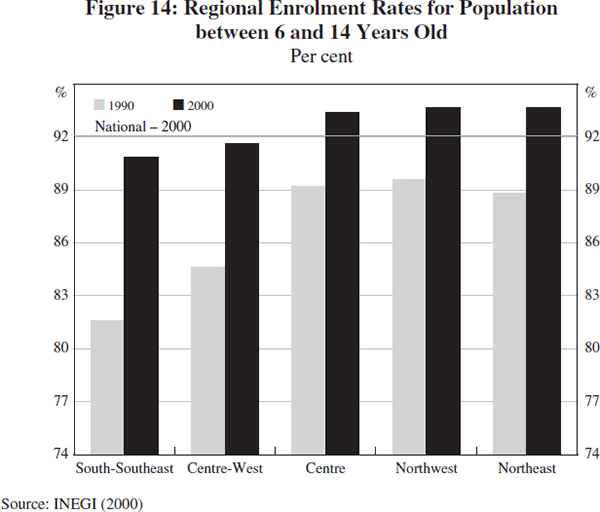
A recent study by the World Bank (2001) has also highlighted improvements in terminal efficiency in primary education in Mexico, with the rate rising from 70 per cent in 1990 to 86 per cent in 1999. These improvements reflected lower repetition and dropout rates. However, there were also striking differences among states: the South-Southeast region recorded an efficiency rate in primary education of 72 per cent, almost 15 percentage points below the national average.
Improvements in basic education also reflected changes in the allocation of public resources. Public spending in education, for instance, increased from 3 per cent of GDP in 1989 to 5 per cent of GDP in 1999. More importantly, public education spending per student increased despite the growth in total student population.
However, as indicated by the World Bank study, there are at least three challenges that are yet to be solved. First, improvements in quantity in the supply of educational services need to be accompanied by an increase in quality factors. Second, enrolments need further improvement, particularly in lower secondary level where it is still low (68 per cent in urban areas). Third, the gap between urban and rural areas needs to be reduced. In primary education, for instance, access in urban areas is close to universal, whereas in the poorest rural areas attendance is still relatively low (85 per cent).
Health and social security is another equity-enhancing area where there has been significant improvement over the past decade. According to the World Bank, ‘Mexico's many achievements in the health sector over the past several decades have led to significant improvements in the health status of the population, a broadening of access to basic services, and support of important public health measures. Rising prosperity has brought an increase in life expectancy, reductions in infant mortality and a decline in the death rate’ (World Bank 2001, p 410). Among the most outstanding improvements of the past decade are: the drop in mortality rate for children under age 5, which fell 37 per cent in that period, and in mortality from pneumonia and diarrhoea, which dropped 65 per cent. Vaccine-preventable diseases in general were drastically reduced (World Bank 2001).
These achievements were due to far-reaching health and anti-poverty measures, through the use of centralised institutions and vertical programs. However, when looking at regular health care services through social security, it is clear that these improvements have not equally benefited all regions (Figure 15). Nationwide, the 2000 Census indicated that only 41 per cent of the population had access to health care through social security. It is worth pointing out that in the northern state of Coahuila this increased up to 70 per cent of the total population, while in the southern state of Chiapas it was less than 20 per cent.
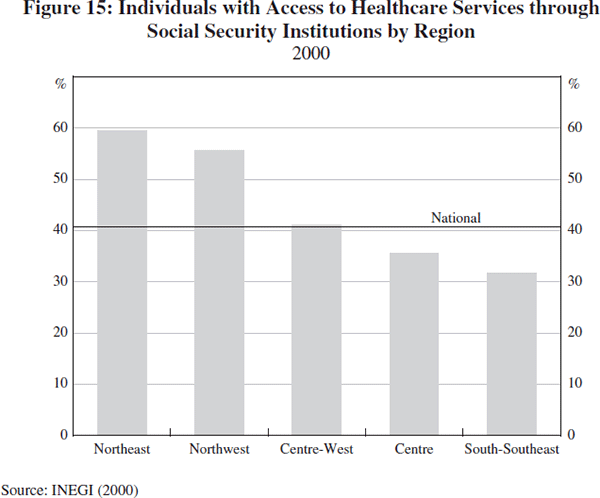
Expanding social security is particularly important given the changing epidemiological profile typical of middle-income countries like Mexico. With chronic diseases and injuries becoming the main cause of death or disability, and emerging public health concerns such as AIDS, the demand for specialised health care has increased. Mexico still faces major challenges in terms of integrating a fragmented health care sector and ensuring equity through issues of coverage and funding priorities, particularly since health expenditure in Mexico is lower than in other OECD and Latin American countries.
Employment and wages
Analysing the effects on employment and wages is crucial for assessing the benefits for workers stemming from global economic integration. After opening up the economy, Mexico saw a significant shift in the employment structure during the 1990s. As shown by the 2000 Census, the industry sector remained practically unchanged, accounting for 28 per cent of the total employed population. By contrast, commerce and services increased from 46 per cent to 54 per cent, at the expense of the primary sector, which in turn dropped from 23 per cent to 16 per cent.
The 2000 Census revealed that women have been increasing their participation in the labour market. In 1990, only 20 per cent of women in productive age were in the labour market, whereas in 2000 this increased to 31 per cent (Figure 16).
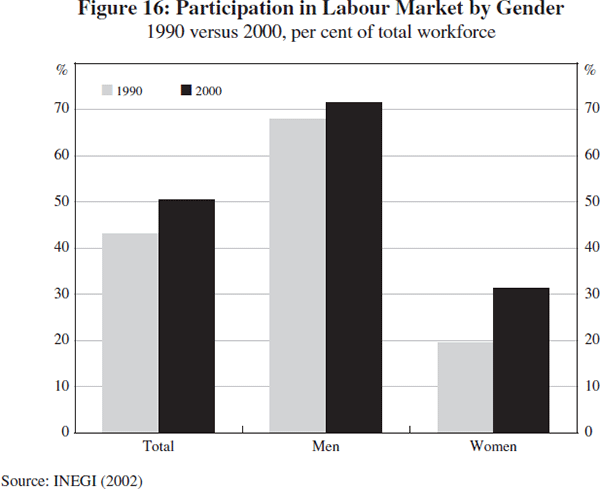
The Census also shows some improvements in income levels, specifically among urban workers (Figure 17). Those receiving less than one minimum salary decreased from around 12 per cent in 1990 to 11 per cent in 1999, while those earning between one and two minimum salaries dropped from 46 per cent to 32 per cent, respectively. By contrast, urban workers earning between two and five minimum salaries reportedly increased from 27 per cent to 37 per cent, while those earning more than five minimum salaries moved from around 7 per cent to 12 per cent.
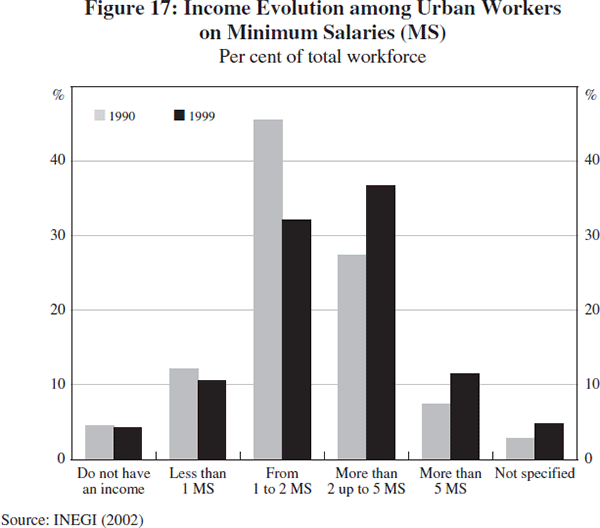
Additionally, it should be noted that empirical evidence in Mexico confirms the notion that FDI brings a skill premium, that is, the extra pay that skilled workers get relative to unskilled workers – a pattern which has been observed in several developing countries (World Bank 2001). When examining the evolution of relative wages for skilled workers in Mexico during the 1980s, Feenstra and Hanson (1997) found that, in regions where FDI is concentrated, growth in FDI can account for over 50 per cent of the increase in the skilled labour wage share that occurred in the late 1980s. Similarly, in a more recent study undertaken in the North of the country, where FDI in the form of maquiladoras is highly concentrated, Mendoza Cota (2002) found out that, on average, the pay for manufacturing workers increases 4 per cent for each additional year of education.
Policy responses and challenges for the future
Mexico's experience with globalisation indicates that no sustainable improvements in equity and living standards can be achieved without first securing macroeconomic stability and economic growth. As shown in the 1994–95 crisis in Mexico, as well as in other recent international episodes, globalisation exposes bad economic management with unprecedented severity and a high social cost, affecting living standards and wiping out many social improvements. For this reason, Mexican authorities are committed to securing conditions for sustainable economic growth as the cornerstone of any successful policy aimed at raising living standards.
However, economic growth is a necessary but not sufficient condition for improving equity and living standards, particularly in countries such as Mexico, with a long-standing legacy of poor income distribution and far-reaching regional disparities. Specific public policies can therefore play a key role in addressing the sources of inequality, while equipping the population with the means to benefit from increasing links with the world economy. Fiscal policy – taxation and spending – appears, therefore, as the most evident tool for tackling this challenge.
With tax policies increasingly showing their limitations, particularly given the reduced margin for manoeuvring under closely intertwined economies, the expenditure side of the budget has thus become a more effective equity-enhancing tool. As recognised by the IMF, ‘the link between income distribution and social spending – especially spending on health and education, through which governments can influence the formation and distribution of human capital – is particularly strong, and public investment in human capital can be an efficient way to reduce income inequality over the long-run’ (IMF 1998, pp 6–7).
Over the past few years, Mexico has developed a consistent social policy under this approach; that is, reducing poverty and enhancing human capital formation through increasing and more focused public spending. This policy has revolved around six strategic guidelines:
1. Increasing budgetary resources for social spending
Social spending in Mexico has reached historical levels. After a decade of steady increase, in 2001 it represented 62 per cent of total programmable spending, compared to 38.2 per cent in 1990 (Figure 18). This has entailed a significant restructuring in public spending, as indicated by the fact that between 1994 and 2000 social spending per capita increased by almost 13 per cent, despite the 5 per cent reduction in programmable spending per capita observed during that period of time.
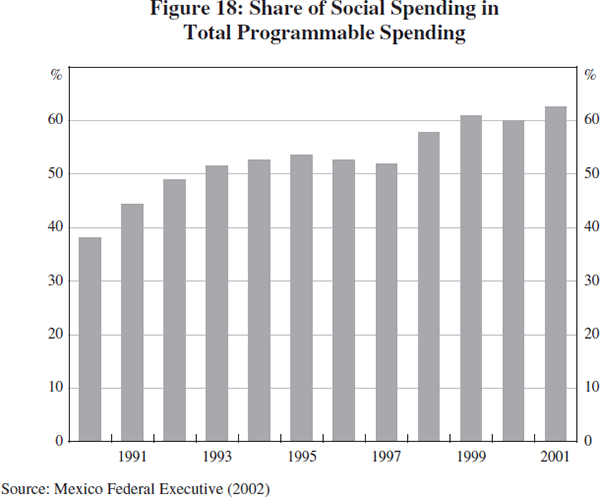
More importantly, this steady increase in social spending has been achieved keeping fiscal discipline and despite relatively low taxation levels. With tax revenues remaining unchanged at levels of 12–13 per cent of GDP over the past decade, increasing tax revenues remains a major challenge for expanding social spending in Mexico, particularly since it still remains low by OECD standards.
2. Enhancing the redistributive impact of social spending
Spending on social security, education, health and labour training has been emphasised due to their high redistributive impact. A fundamental step in this direction was the 1997 social security reform, which increased coverage and established the basis for improving the system's financial viability. In addition to a major overhaul of the pension system of the private sector – which included the introduction of a fully funded system in place of the old pay-as-you-go scheme – the costs of contribution to the health segment of social security were thus reduced for both employers and employees.
Equity concerns in the reform of the social security system led to the development of mechanisms to provide health services to the uninsured population through a low fixed contribution. The pension component also had a redistributive impact in favour of the low-income workers, since the government makes a lump-sum transfer to the savings account of all workers regardless of their wage level. In addition, by expanding education and health services to the low-income segments of the population, including scholarships and other incentives for securing access for the poorest families, the equity orientation of social spending was enhanced.
This is a particularly relevant shift in government expenditure, considering that in the past public spending actually increased income inequality through transfers to better-off population groups. This included, for instance, across-the-board food subsidies or agricultural credit subsidies, which were later eliminated or modified. In this aspect, the opening of the Mexican economy and the need to improve public finances contributed to including more and better focused equity concerns in public spending.
3. Targeting spending in poverty alleviation programs
Special emphasis in social spending has been placed on programs specifically targeted at poverty alleviation. In particular, two specific changes in the nature of subsidies have been incorporated:
- a shift from pure income transfers to transfers conditional on investment in human capital (health, education and nutrition); and
- a shift from generalised to targeted food subsidies, along with a better balance between urban and rural areas.
The measures to enhance human capital formation attempted to improve both supply and demand. On the supply side, actions were taken to improve quantity and quality of health and education services for the most vulnerable segments of the population. At the same time, demand-side measures were incorporated through new mechanisms such as school breakfasts and school grants. One of the main instruments of this demand-side instrument was the creation of the integrated Education, Health and Nutrition Programme (PROGRESA) in 1997. Originally covering only isolated rural areas, PROGRESA was modified in 2001 to include poor urban areas as well. Currently, PROGRESA covers more than 3 million families in 31 states.
PROGRESA combines a traditional cash transfer programme with financial incentives for families to invest in the human capital of their children.[10] The size of the cash transfer is large, approximately one-third of household income for the beneficiary families. Another specific feature of the program is that the mother of the family receives the cash transfers, in the belief that this way the funds can be more effectively channelled to children's education and nutrition. Recent evaluations undertaken by the Washington-based Food Policy Research Institute have found that PROGRESA has been an effective tool in reducing poverty levels while increasing education attainments, reducing child work and improving overall health conditions.[11] Indeed, this success has led several experts to recommend the application of similar programmes in other countries (Krueger 2002).
In addition to investment in human capital, poverty alleviation policies in Mexico have included investment in basic social infrastructure (sewerage, drinking water, rural roads, telephones, etc) and development of income generation programs (public works, micro-enterprises, etc).
4. Decentralising social spending
Social spending in Mexico is increasingly channelled through the state and municipal governments rather than the federal government, as it used to be in the past. A drastic change in the composition of social spending between the federal and the state and local governments has occurred through two mechanisms: federal grants (aportaciones federales) and resource allocation agreements or decentralisation agreements.[12]
Created in 1998, federal grants are allocated to the states for specific social programs on an annual basis, according to transparent rules and clear responsibilities of the three levels of government (federal, state and municipal) regarding the execution, monitoring and accountability. Federal grants are divided into funds earmarked for specific attributions: basic education, health care services, poverty alleviation, technological and adult education, etc. This way, sub-national governments act as an agent of the federal government for carrying out a coherent nation-wide social policy, while providing legal security over resource availability.
Resource allocation agreements have been another mechanism to decentralise social spending. Although keeping their status as federal ear-marked resources, overall management of the funds is transferred to the states. This scheme has been used primarily for fuelling resources for education and health care services.
It should be noted that decentralisation of public spending, of which education and health care services have been a large component, has been a major transformation in Mexico's public finances. Whereas in 1993, sub-national governments spent only 39 centavos for each peso spent by the federal government, by 2002 this proportion had been reversed and sub-national governments were spending 1.32 pesos for each peso spent at the federal level.[13] It is considered that this process has reached a limit since federal transfers have not been matched by revenue-enhancing measures among sub-national governments. This indeed has become a major challenge, not only for increasing funds for local social development, but also for enhancing the effectiveness of public spending.
5. Increasing transparency and accountability
Over the past few years, important steps have been taken to increase transparency and accountability in public spending, while reducing discretionary powers. Since 1999, for instance, the Budget Decree establishes the obligation for all federal agencies to publish specific operation rules for any program entailing income transfers. These operation rules include: criteria for identifying the target population, mechanisms for regular evaluation, clear limitations to discretionary powers and coordination requirements among public agencies to avoid duplication and promote consistency across the board.
Although significant improvements have been taken at the federal level, consolidating this process among local authorities remains a major challenge. This entails institutional strengthening and a more active involvement of society.
6. Incorporating regional considerations into social spending
Given the significant regional gaps in social development, Mexican authorities have recently incorporated a major regional component in their social spending strategy through two programmes launched in 2001:
- The Puebla-Panama Plan is a far-reaching long-term plan aimed to develop the South-Southeast region by strengthening economic links with Central America.[14] In addition to an international dimension involving a portfolio of integration projects, domestically the Puebla-Panama Plan includes a comprehensive set of social development, infrastructure, and productive policies.
- The Micro-Regions Programme, in turn, was designed to provide a comprehensive set of social policies targeting 476 municipalities throughout the country, including all the 5 regions in which the country has been divided for planning purposes. These municipalities were identified as having the highest social marginalisation indices in Mexico, comprising to a large extent indigenous people.
Concluding remarks
Mexico's insertion into what has been considered the ‘third wave’ of globalisation has brought several benefits, although strongly differentiated along regional lines. Economic growth, export performance and FDI flows are closely linked with broader social improvements, as seen in those Mexican regions with stronger global economic integration.
Poverty and extreme poverty show a downward trend, particularly notable in urban and more outward-oriented regions. Income inequality has remained relatively unchanged at a national level, while some improvements can be seen in northern urban areas, where global economic integration is growing. In terms of education, health and broader social indices, substantial improvements at a national and regional level have occurred over the past decade.
Mexico's experience with globalisation also shows that progress in equity and living standards cannot be achieved without an appropriate economic policy mix aimed at securing both macroeconomic stability and economic growth. Nevertheless, the fact that half of the population is still in poverty or extreme poverty calls for renewed efforts on human capital formation, institution-building and reform, so that the benefits of globalisation can be effectively extended to broader segments of the population.
Economic policy-makers in Mexico have therefore speeded the pace of structural reform and adopted a pro-growth and pro-‘public spending on the poor’ policy through increasing equity and social considerations. Social development and equity policies have been increasingly addressed by relying more on the public spending side of the budget, without affecting the overall soundness of public finances.
Footnotes
Moisés J Schwartz is Director General for International Financial Affairs at the Mexican Ministry of Finance. This paper reflects his personal views and by no means can be considered an institutional point of view. The author would like to thank Salvador Pérez Galindo, Paula Villavicencio, Karla Mejía and Moramay López Alonso for their valuable contribution to this paper. [1]
Corbacho and Schwartz (2002) mention the first two factors for Mexico, whereas Easterly (2001) stresses the latter for several countries, including Mexico. [2]
The 2001–2006 National Development Plan identifies the following five regions:
- the Centre, comprising the Federal District, Hidalgo, Morelos, Querétaro, the state of México and Tlaxcala; concentrating 32.1 per cent of total population;
- the Centre-West, including Michoacán, Aguascalientes, Colima, Guanajuato, Jalisco, Nayarit, San Luis Potosí and Zacatecas, with 23.5 per cent of the population;
- the Northeast, comprising Chihuahua, Coahuila, Durango, Nuevo León and Tamaulipas, with 13.6 per cent of total population;
- the Northwest, including Baja California Norte, Baja California Sur, Sinaloa and Sonora, with 7.6 per cent of total population; and
- the South-Southeast, comprising Campeche, Chiapas, Guerrero, Oaxaca, Puebla, Quintana Roo, Tabasco and Veracruz, with the remaining 23.2 per cent of total population.
The Lorenz curve reflects the degree of income inequality in a society. It is supposed that in a society with perfectly equal income distribution, the cumulative share of income would be equal to the cumulative population share (represented by the 45° line). The Gini coefficient measures the deviation with respect to such a line, with a value of ‘0’ being the most equal and ‘1’ the most unequal. [4]
See Corbacho and Schwartz (2002) and World Bank (2001). However, the World Bank recognises that international comparisons are particularly difficult to undertake given the differences in concepts measured. [5]
Moderate poverty is defined as the proportion of population with a daily per capita income of less than the value of a food basket with the minimum nutrients and calories for survival, plus housing, clothing, education and health. This daily income is equivalent to the value of a food basket multiplied by 2 and 1.75 for urban and rural zones, respectively. Extreme poverty is defined as the proportion of population with a daily per capita income of less than the value of the same food basket, excluding housing, clothing, education and health. As of April 2002, the daily income to be considered poor was equivalent to approximately US$4.83 for urban areas and US$3.58 for rural areas; whereas to be considered extremely poor it was US$2.41 and US$1.79, respectively. [6]
The HDI is based on three indicators: (i) longevity, as measured by life expectancy at birth; (ii) educational attainment, as measured by a combination of adult literacy (two-thirds weight) and the combined gross primary, secondary and tertiary enrolment ratios (one-third weight); and (iii) standard of living, as measured by real GDP per capita measured at purchasing power parity dollars. The BWI is calculated with four indicators equally weighted at 0.25: (i) adult literacy; (ii) life expectancy at first year; (iii) infant mortality; and (iv) secondary education enrolment. Finally, the PQLI is based on two health indicators and one about education, each of them weighted equally as one-third: (i) adult literacy; (ii) life expectancy at first year; and (ii) infant mortality. [7]
The Marginalisation Index has five levels of intensity: very high, high, medium, low and very low. It combines the following variables: percentage of illiterate individuals older then 15 years of age; percentage of individuals living in their own house with no sewerage; percentage of individuals living in their own house with no electricity; percentage of individuals livings in their own house with no drinking water system; percentage of population living in overcrowded housing; percentage of individuals living in soil-floor houses; and percentage of working population earning less than two minimum wages. [8]
Data for 1997 indicate that this was the case for 8 and 9-year-old children. In the former case, boys had an enrolment rate of 97.1 per cent and girls 97.6 per cent, while in the latter it was 97.5 per cent and 97.7 per cent, respectively (World Bank 2001). [9]
The family only receives the cash transfer if: (a) every family member accepts preventive health services; (b) children aged 0–5 and lactating mothers attend nutrition monitoring clinics where their growth is measured, they obtain nutrition supplements, and they receive education on nutrition and hygiene; and (c) pregnant women visit clinics to obtain prenatal care, nutritional supplements and health education. An additional cash transfer is given to households with school-age children if the children are enrolled and attend school. [10]
For a summary of these evaluations, see IFPRI (2002). [11]
Federal participations (Participaciones federales) are the third mechanism for transferring federal public spending to sub-national governments. These are transfers in the form of revenue sharing, that is, they are determined automatically as a pre-established percentage of revenue. Once the funds are transferred, they are considered local resources which are spent depending upon the priorities of each sub-national government. [12]
This proportion refers to primary expenditure, excluding state-owned enterprises. It is obtained by dividing the expenditure of states and municipalities by the expenditure exercised directly by the Federal Government of Mexico (SHCP 2001). [13]
The Puebla-Panama Plan is a joint governmental effort launched with the support of the Inter-American Development Bank, aimed at boosting integration and economic development in nine states in the South-Southeast region of Mexico (Campeche, Chiapas, Guerrero, Oaxaca, Puebla, Quintana Roo, Tabasco, Veracruz and Yucatan), as well as in seven Central American countries (Belize, Costa Rica, El Salvador, Guatemala, Honduras, Nicaragua and Panama). This region stretches over more than one million square kilometres and has approximately 65 million inhabitants. Despite its wealth of natural resources and proximity to major markets, its extreme poverty index is three times higher than the Latin American average. [14]
References
Andalón-López M and LF López-Calva (2002), ‘The Many Mexicos: Regional Income Inequality and Polarization during the Nineties’, El Colegio de México, mimeo.
CONAPO (National Population Council) (2002a), ‘Índices de Desarrollo Humano, 2000’, available at <http://www.conapo.gob.mx/publicaciones/principal.html>.
CONAPO (2002b), ‘Índices de Marginación, 2000’, available at <http://www.conapo.gob.mx/publicaciones/principal.html>.
CONAPO (2002c), ‘Población de México en Cifras’, available at <http://www.conapo.gob.mx/m_en_cifras/principal.html>.
Corbacho A and G Schwartz (2002), ‘Mexico: Experiences with Pro-Poor Expenditure Policies’, IMF Working Paper WP02/12.
Easterly W (2001), The Elusive Quest for Growth: Economists' Adventures and Misadventures in the Tropics, MIT Press, Cambridge.
Feenstra RC and GH Hanson (1997), ‘Foreign Direct Investment and Relative Wages: Evidence from Mexico's Maquiladoras’, Journal of International Economics, 42(3/4), pp 371–393.
IFPRI (International Food Policy Research Institute (2002), PROGRESA: Breaking the Cycle of Poverty, Washington DC.
IMF (International Monetary Fund) (1998), ‘Should Equity be a Goal of Economic Policy?’, Fiscal Affairs Department, Economic Issues Series No 16.
INEGI (National Institute of Statistics, Geography and Informatics) (2000), ‘XII Censo General de Población y Vivienda 2000, Tabulados de la muestra censal, Cuestionario ampliado’, available at <http://www.inegi.gob.mx>.
INEGI (2002),‘Estadísticas sociodemográficas de mediano plazo’, available at <http://www.inegi.gob.mx/estadistica/espanol/sociodem/sociodem.html>.
Krueger AB (2002), ‘Economic Scene: A model for evaluating the use of development dollars south of the border’, The New York Times, 2 May, p 2.
Mendoza Cota JE (2002), ‘Educación, experiencia y especialización manufacturera en la frontera norte de México’, Comercio Exterior, 52(4), pp 300–308.
Mexico Federal Executive (2002), ‘Plan Nacional de Desarrollo, Primer Informe de Ejecución’, Poder Ejecutivo Federal.
Mexico Ministry of Economy (2001), ‘Informe Estadístico sobre el Comportamiento de la Inversión Extranjera Directa en México (Enero–diciembre de 2000)’, Comisión Nacional de Conversiones Extranjeras.
SHCP (Ministry of Finance and Public Credit) (2001), ‘Proyecto de Presupuesto de Egresos de la Federación para el Ejercicio Fiscal 2002’, available at <http://www.shcp.gob.mx/docs/pe2002/pef/menu.html>.
Tamayo-Flores R (2001), ‘Mexico in the Context of the North American Integration: Major Regional Trends and Performance of Backward Regions’, Journal of Latin American Studies, 33(2), pp 377–407.
UNDP (United Nations Development Programme) (2001), Human Development Report 2001: Making New Technologies Work for Human Development, Oxford University Press, New York.
van der Lijn N (1995), ‘Measuring well-being with social indicators, HDIs, PQLI and BWI for 133 countries for 1975, 1980, 1985, 1988, and 1992’, Tilburg University, Faculty of Economics and Business Administration Research Memorandum No 704.
World Bank (2001), Mexico: A Comprehensive Development Agenda for the New Era, The World Bank Group, Washington DC.
World Bank (2002a), ‘Data and Statistics’, available at <http://devdata.worldbank.org/data-query/>.
World Bank (2002b), Globalization, Growth, and Poverty: Building an Inclusive World Economy, The World Bank Group and Oxford University Press, New York.
2. Xie Ping
The Chinese economy has grown very quickly over the 20 years since China began opening to the outside world, although income per capita remains low because of the country's large population.
Economic growth has inevitably increased inequality, including inequality between city and rural areas, between different regions, and between the employed and unemployed. The Chinese government has introduced a number of measures to reduce inequality, which the government hopes will contribute to social stability. These measures include:
- Setting up a safety net that provides income security as well as job opportunities for the unemployed.
- Introducing a strategy called ‘developing the west’, aimed at reducing inequality between coastal and inland cities, and between northern and southern cities.
On the topic of measuring poverty, I do not believe that the standard poverty measure of ‘one dollar per person per day’ is appropriate. For example, it cannot be applied to all countries because consumption and price levels may not be comparable across countries or regions. This measure is particularly unsuitable for measuring poverty in inland and rural China.
With regard to the effect of globalisation on poverty and inequality, I think of it as a double-edged sword. This is especially true for developing countries. Although globalisation has brought China significant economic benefits it has, at the same time, enlarged the gap between the rich and poor. Many other developing countries have had the same experience. In addition, it is important that the currently developed countries also become more open. For example, some developed countries only allow the flow of goods and capital from developing countries, not technology and labour. This only puts more obstacles in the path of developing countries' attempts to improve their living standards.
Here are some thoughts on how inequality across countries can be reduced:
- Developed countries should provide more opportunities and more capital to developing countries. They could provide debt relief, open their markets, and facilitate technology transfer to developing countries.
- Developing countries should make efforts to find the ‘comparative advantages’ and development paths that will allow them to benefit from globalisation.
3. Y Venugopal Reddy
I would like to place on the record our deep appreciation for the excellent arrangements made for the G-20 Workshop, the outstanding hospitality of the Australian authorities, and the insight of the papers presented.
The idea to present country case studies has proved to be quite useful. In particular, the paper on India was comprehensive, thorough, and captures most of the features of India's experience with globalisation. Dr Kishore should be complemented for this.
By way of summary, Dr Kishore characterised India's experience with globalisation as, in many ways, unique. He outlined how Indian policy had changed with respect to external trade, capital flows, and the financial sector. His analysis of the effect of globalisation showed that: average growth increased from 3.5 per cent per annum prior to 1983, to 5.6 per cent per annum between 1983 and 1992, and to 6.1 per cent per annum after 1992; evidence about the effect on employment trends was mixed; the financial sector was stable and strong; inflation was benign; forex reserves increased; and trade openness increased after 1987.
His analysis also showed that living standards improved significantly, although it should be remembered that ‘well-being’ is more important in the Indian context. The paper also noted that inequality had increased in India between individuals and regions. He concluded by arguing that there was no single model for countries attempting to become more integrated with the world economy, and that no causality from globalisation to growth and poverty reduction had been established. He thought that there was a clear role for governments in ensuring that growth was equitable, and that the transition to an open economy was managed properly.
The comments on India's experience with globalisation that follow are offered wearing my academic hat rather than my central banker's hat, and relate to the broader questions that arise from this experience.
First, the link between economic performance and globalisation must be assessed. Because India's average growth rate during the 1990s was about the same as during the 1980s (and even a percentage point lower since 1997), it is unclear whether globalisation (which commenced in India in 1992) or domestic deregulation (which began in the 1980s) had a larger effect on Indian growth. Indeed, the lower average growth since 1997 has coincided with a deepening of India's integration with the world economy and a period of global uncertainty.
Second, in his presentation Professor Wade alluded to the need to distinguish between internal and external integration. In India, of the seven important reforms undertaken since the 1980s, three were part of the deregulation of the domestic sector[15], and four related to the external sector.[16] There are clear difficulties in identifying which reforms (and in what combination) had the largest effect on the Indian economy, and hence identifying the impact of globalisation. It does seem, however, that Professor Wade's comments are valid and that improving both India's internal and external integration have been important.
Third, with regard to the stability of the economy, I agree with Dr Kishore that the economy showed great resilience to internal and external uncertainties during the 1990s. For example, although inflation has remained under control in India for most of the period since independence, it has been particularly benign in recent years. Further, the country's financial markets have withstood the Gulf crisis of 1991–92, the Asian crisis of 1997, and more recently September 11.
Fourth, the stability of India's currency was relatively unaffected by the Asian crisis. Indeed there was a view that the country withstood the shock of the Asian crisis because it remained a relatively closed economy. Thus, the interesting question is – what was of most benefit to the economy, its relatively closed nature, or its improved openness in combination with prudent macroeconomic policies?
Fifth, I agree with the paper that India's balance of payments has been very strong since the economy opened up. This outcome was attributed by the paper to current account convertibility, the cautious liberalisation of the capital account, an emphasis on non-debt creating flows, accretion to reserves, and the maintenance of a flexible exchange rate while simultaneously avoiding excess volatility of the exchange rate.
In my view, the strength of the balance of payments can be explained in several other ways. For example, the accretion to reserves can be explained by increased workers' remittances, growing software exports, and a current account deficit of around 1 per cent of GDP. The increase in workers' remittances reflects the lowering of migration barriers in some countries, while the low current account deficit reflects the increased absorptive capacity of the economy. Thus, in the Indian case, the question that needs to be asked is: is the strength of the external sector due to prudent external sector and exchange rate management, or the outward orientation of the economy?
Sixth, with regard to the labour market, the paper noted that there was a marginal increase in employment in the organised sector, but the evidence is mixed on whether globalisation has affected employment growth in the unorganised sector. Further, interstate disparities in employment growth have widened.
Seventh, evidence in the paper clearly points to reductions in poverty during the 1990s, although evidence suggests that poverty also fell in the 1980s. There is, therefore, a need to determine whether the gains of the 1990s represent a new trend, or an acceleration of the trend over the 1980s when the Indian economy had barely opened up. Such an analysis would require more disaggregated poverty data.
Eighth, the paper demonstrates that it is not clear whether globalisation has accentuated inequality across states. Indeed, the paper argues that a state's coastal location and its development policies may be more important.
Ninth, as Vito Tazi, a noted economist has observed, the capacity of the government to raise taxes at a time when the country is in the process of opening up is reduced. This is alluded to in the paper when India's persistent fiscal deficit is mentioned. Indeed, the central government has alone run a deficit of over 5 per cent of GDP over the last 10 years. This is in addition to the rising provincial government fiscal deficits. So, although the government needs more resources for public good provision during the globalisation process, its capacity to raise taxes, both direct and indirect, has been reduced. The issue, therefore, is whether globalisation, which on one hand provides the opportunity for developing countries to grow faster, may on the other reduce the capacity of governments in developing countries to equip their citizens with the skills necessary to compete in the global economy.
Tenth, flexible product and factor markets are critical for globalisation to have a positive effect on the economy. While capital can move or be withheld, labour can neither move easily across borders, nor can a worker withhold his labour, since an income is necessary for survival. Hence, a flexible labour market cannot be assumed in a country where there is no social security because there are limits to retrenchment. The world order, as it exists today, does little to strengthen national governments in terms of raising revenue, nor does it provide protection for workers or the poor in times of crisis. Because national governments continue to be responsible for looking after their country's poor, they become, in the absence of mechanisms to cope with the shocks associated with globalisation, averse to opening the economy too much. Thus, the international community needs to assist national governments to cope with external shocks so that globalisation continues to be embraced by developing countries.
Finally, as Dr Kishore observed, although poverty fell significantly in both China and India during the 1990s, poverty reduction was far less impressive in many other developing countries, despite even more far reaching reforms being implemented in many of them. This raises the question as to whether India and China's success can be attributed to their reforms associated with globalisation, or to non-globalisation-related domestic reforms. Answering this question is important because it will shape the optimal policy choices of other developing countries in the globalisation era.
Footnotes
They were the dismantling of industrial licensing, the opening of publicly owned and managed industries to private sector participation, and the abolition of the Monopolies and Restrictive Trade Practices Act. [15]
They were the switch from a fixed exchange rate to a flexible exchange rate, the removal of quantitative restrictions on imports, the reduction of the peak custom tariff, and market orientation in the management of the external sector. [16]
4. General Discussion
The papers by Shang-Jin Wei and Adarsh Kishore, on the Chinese and Indian experiences with globalisation, generated discussion on three main topics. First, why did some countries not attract foreign direct investment (FDI), despite appearing to get their policy settings right? Second, the importance of microeconomic, as well as macroeconomic, policy for generating growth. And third, why the benefits of globalisation were often unevenly distributed across regions within developing countries, and how policy-makers should respond to this development.
The discussion began with the observation that a number of developing countries have failed to attract significant FDI over the last 10 years, despite often having sound institutions, relative macroeconomic stability and open trading regimes. One participant noted that there were a number of non-policy factors that could influence whether a country was a favourable destination for FDI. The two factors discussed in most detail were the size of a country's domestic markets, and its proximity to foreign markets or trade routes. For example, both China and India may have become popular destinations for FDI because of the size of their domestic markets and their potential to expand significantly. The Mexican experience was also discussed to highlight the benefits of proximity to a large market. For firms wanting to sell into the US market, regions in Mexico bordering the US were an ideal location for investment because they combined access to a pool of relatively cheap labour with low transport costs. One participant was, however, keen to bring the subject of openness back into the discussion, arguing that although economic geography did influence investment flows, imposing barriers to trade with the rest of the world could only exacerbate geographic constraints. Drawing on the results in Shang-Jin Wei's paper, this participant likened the imposition of barriers to trade to artificially increasing a region's distance from world markets, with similar economic effects.
Although a number of participants acknowledged the constraints that economic geography placed on countries' growth potential, there was also discussion of the failure to focus enough attention on microeconomic policy. Inefficient ports, a lack of internal infrastructure, excessive government intervention in markets for non-public goods, delays and expenses for firms to set up, etc, all created an environment that was not conducive to either private domestic or foreign investment. It was pointed out that the importance of microeconomic reform to productivity growth had long been recognised in developed countries, and that such reform processes were also important in developing countries. It was, however, recognised that the human resources required to carry out such policy reforms were often lacking in developing countries, and there was therefore a large role for aid agencies and institutions such as the World Bank to provide technical assistance.
Finally, there was some discussion of why the integration of a country into the global market-place, and hence the benefits of globalisation, was often unevenly distributed across regions within a county. For example, coastal China benefited more than western inland China, and the regions of Mexico bordering the US were much more integrated with that economy than regions such as Chiapas in the south. For many, this was further evidence that economic geography, which could influence relative growth rates across countries, was also important in explaining growth differentials across regions within countries. One participant thought that the distribution of benefits across regions within a country was like a zero-sum game. Specialisation and localisation meant that only a subset of regions within a country could become integrated with the global economy, and hence some regions were bound to prosper more than others. Because of this concentration of the benefits of globalisation within a small number of regions within a country, it was argued that a national system of transfers might be desirable to ensure that the benefits were more evenly distributed.